Shades of blue
| Blue | |
|---|---|
| Wavelength | 440–490 nm |
| Hex triplet | #0000FF |
| HSV (h, s, v) | (240°, 100%, 100[1]%) |
| sRGBB (r, g, b) | (0, 0, 255) |
| Source | X11 |
| B: Normalized to [0–255] (byte) H: Normalized to [0–100] (hundred) | |
Varieties of the color blue may differ in hue, chroma (also called saturation, intensity, or colorfulness), or lightness (or value, tone, or brightness), or in two or three of these qualities. Variations in value are also called tints and shades, a tint being a blue or other hue mixed with white, a shade being mixed with black. A large selection of these colors is shown below.
Wrapping the spectrum into a color wheel[]
In a color proximity sense, a primary color has a color range of 120° (60° on each side of the color's hue) and any color has to be within that range to be considered a variation of that color. Secondary colors have a color range of 60° (30��), tertiary colors have a color range of 30° (15°), quaternary colors have a color range of 15° (7.5°), quinary colors have a color range of 7.5° (3.75°), and so on. Because blue is located at a hue angle of 240°, it has a tertiary color range of 225° and 255°, and any color out of this range is more related to azure or violet than blue.


Definitions of blue[]
Blue (RGB) (X11 blue)[]
| Blue (Computer web color) | |
|---|---|
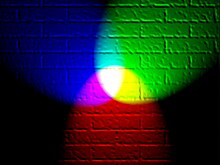 Red, green, and blue lights, representing the three basic additive primary colors of the RGB color system, red, green, and blue | |
| Hex triplet | #0000FF |
| HSV (h, s, v) | (240°, 100%, 100%) |
| sRGBB (r, g, b) | (0, 0, 255) |
| Source | X11 color names[2] HTML/CSS[1] |
| ISCC–NBS descriptor | Vivid blue |
| B: Normalized to [0–255] (byte) | |
The color defined as blue in the RGB color model, X11 blue, is shown at right. This color is the brightest possible blue that can be reproduced on a computer screen, and is the color named blue in X11. It is one of the three primary colors used in the RGB color space, along with red and green. The three additive primaries in the RGB color system are the three colors of light chosen such as to provide the maximum gamut of colors that are capable of being represented on a computer or television set.
This color is also called color wheel blue. It is at 240 degrees on the HSV color wheel, also known as the RGB color wheel. It is a spectral color which lies at, or near, the short-wave (violet) end of the traditional "blue" and possibly was classified as "indigo" by Newton.[3] Its complementary color is yellow.
Blue (CMYK) (pigment blue)[]
| Blue (CMYK) (pigment blue) | |
|---|---|
 | |
| Hex triplet | #333399 |
| HSV (h, s, v) | (240°, 67%, 60%) |
| sRGBB (r, g, b) | (51, 51, 153) |
| Source | CMYK |
| ISCC–NBS descriptor | Vivid blue |
| B: Normalized to [0–255] (byte) H: Normalized to [0–100] (hundred) | |
The color defined as blue in the CMYK color system used in printing, also known as pigment blue, is the tone of blue that is achieved by mixing process (printer's) cyan and process (printer's) magenta in equal proportions.
The purpose of the CMYK color system is to provide the maximum possible gamut of color reproducible in printing by the use of only three primaries.
The color indicated is only approximate as the colors of printing inks may vary.
Blue (Pantone)[]
| Blue (Pantone) | |
|---|---|
| Hex triplet | #0018A8 |
| HSV (h, s, v) | (231°, 100%, 66[4]%) |
| sRGBB (r, g, b) | (0, 24, 168) |
| Source | Pantone TPX[5] |
| ISCC–NBS descriptor | Vivid blue |
| B: Normalized to [0–255] (byte) | |
Blue (Pantone) is the color that is called blue in Pantone.
The source of this color is the "Pantone Textile Paper eXtended (TPX)" color list, color # Blue C, EC, HC, M, PC, U, or UP—Blue.[6]
Blue (NCS) (psychological primary blue)[]
| Blue (NCS) | |
|---|---|
 Approximations within the sRGB gamut to the primary colors of the Natural Color System, a model based on the opponent process theory of color vision | |
| Hex triplet | #0087BD |
| HSV (h, s, v) | (197°, 100%, 74%) |
| sRGBB (r, g, b) | (0, 135, 189) |
| Source | sRGB approximation to NCS 2060-B[7] |
| ISCC–NBS descriptor | Moderate blue |
| B: Normalized to [0–255] (byte) | |
The color defined as blue in the NCS or Natural Color System is an azure-like color shown at right (NCS 2060-B). The Natural Color System is a color system based on the four unique hues or psychological primary colors red, yellow, green, and blue. The NCS is based on the opponent process theory of vision.
The “Natural Color System” is widely used in Scandinavia.
NCS Blue can only be displayed approximately on a computer screen, as these spectral colors have been adjusted to fit into the sRGB gamut. In the 21st century, this hue is classified as an variation of azure that is on the border of cyan.
Blue (Munsell)[]
| Blue (Munsell) | |
|---|---|
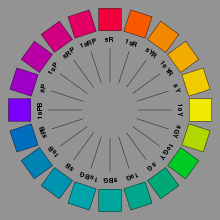 The hues of the Munsell color system, at varying values, and maximum chroma to stay in the sRGB gamut. | |
| Hex triplet | #0093AF |
| HSV (h, s, v) | (190°, 100%, 69%) |
| sRGBB (r, g, b) | (0, 147, 175) |
| Source | Munsell Color Wheel |
| ISCC–NBS descriptor | Strong greenish blue |
| B: Normalized to [0–255] (byte) | |
The color defined as blue in the Munsell color system (Munsell 5B) is shown at right. The Munsell color system is a color space that specifies colors based on three color dimensions: hue, value (lightness), and chroma (color purity), spaced uniformly (according to the logarithmic scale which governs human perception) in three dimensions in the Munsell color solid, which is shaped like an elongated oval at an angle. In order for all the colors to be spaced uniformly, it was found necessary to use a color wheel with five primary colors: red, yellow, green, blue, and purple.
Munsell can only be displayed approximately on a computer screen, as these spectral colors have been adjusted to fit into the sRGB gamut. In the 21st century, this hue is classified as an intermediate between azure and cyan.
Blue (Crayola)[]
| Blue (Crayola) | |
|---|---|
| Hex triplet | #1F75FE |
| HSV (h, s, v) | (217°, 88%, 100[8]%) |
| sRGBB (r, g, b) | (31, 117, 254) |
| Source | Crayola |
| ISCC–NBS descriptor | Vivid blue |
| B: Normalized to [0–255] (byte) H: Normalized to [0–100] (hundred) | |
Blue (Crayola) is the color called blue in Crayola crayons.
"Blue" was one of the original Crayola crayons formulated in 1903.
Crayola can only be displayed approximately on a computer screen. In the 21st century, this hue is classified as an variation of azure that is on the border of blue.
Tints, shades, and variations of blue[]
The term tint and shade is used in its technical sense as used in color theory.
In this section, the term 'tint' usually refers to a blueish color mixed with white or light gray. The term shade is used in its technical sense as used in color theory, meaning a blueish color mixed with black or dark gray.
The colors arranged in order of their value (brightness) (V in the HSV code), the brighter colors toward the top and the darker colors toward the bottom.
Periwinkle[]
| Periwinkle | |
|---|---|
| Hex triplet | #CCCCFF |
| HSV (h, s, v) | (240°, 20%, 100%) |
| sRGBB (r, g, b) | (204, 204, 255) |
| Source | Maerz and Paul |
| ISCC–NBS descriptor | Very light purplish blue |
| B: Normalized to [0–255] (byte) H: Normalized to [0–100] (hundred) | |
Periwinkle (also periwinkle blue or lavender blue) is a mixture of white, blue, and red. It is named after the Periwinkle flower and is also commonly referred to as a tone of light blue.

Ultramarine[]
| Ultramarine | |
|---|---|
 Ultramarine pigment | |
| Hex triplet | #4000FF |
| HSV (h, s, v) | (255°, 100%, 100%) |
| sRGBB (r, g, b) | (64, 0, 255) |
| Source | [Unsourced] |
| ISCC–NBS descriptor | Vivid blue |
| B: Normalized to [0–255] (byte) | |

Ultramarine is a blue pigment in use since medieval times. It was originally derived from lapis lazuli, a bright blue mineral.
Medium blue[]
| Medium Blue | |
|---|---|
| Hex triplet | #0000CD |
| HSV (h, s, v) | (240°, 100%, 80%) |
| sRGBB (r, g, b) | (0, 0, 205) |
| Source | X11 |
| ISCC–NBS descriptor | Vivid blue |
| B: Normalized to [0–255] (byte) | |
The web color medium blue is a shade of the standard (h = 240°) blue.
Savoy blue[]
| Savoy blue | |
|---|---|
| Hex triplet | #4B61D1 |
| HSV (h, s, v) | (230°, 64%, 82%) |
| sRGBB (r, g, b) | (75, 97, 209) |
| Source | ColorSwatches |
| ISCC–NBS descriptor | Vivid blue |
| B: Normalized to [0–255] (byte) H: Normalized to [0–100] (hundred) | |
Savoy blue, or savoy azure, is a shade of saturation blue between peacock blue and periwinkle, lighter than peacock blue.[9] It owes its name to its being the color of the House of Savoy, a ruling dynasty in Italy from 1861 to 1946.
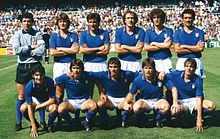
Having become a national color with the unification of Italy (1861), its use continued even after the birth of the Italian Republic (1946) with the name "Italian blue". An Italian-blue border was inserted on the edge of the Presidential Standard of Italy and the use of the blue scarf for the Italian Armed Forces' officers, for the presidents of the Italian provinces during the official ceremonies and of the blue jersey for Italian national sports teams it was also maintained in the Republican era.
Liberty[]
| Liberty | |
|---|---|
| Hex triplet | #545AA7 |
| HSV (h, s, v) | (236°, 50%, 66[10]%) |
| sRGBB (r, g, b) | (84, 90, 167) |
| Source | ISCC-NBS[11] |
| ISCC–NBS descriptor | Strong blue |
| B: Normalized to [0–255] (byte) H: Normalized to [0–100] (hundred) | |
Liberty is a strong blue color.
The first recorded use of liberty as a color name in English was in 1918.[12]
Egyptian blue[]
| Egyptian Blue | |
|---|---|
| Hex triplet | #1034A6 |
| HSV (h, s, v) | (226°, 90%, 65%) |
| sRGBB (r, g, b) | (16, 52, 166) |
| Source | webexhibts |
| ISCC–NBS descriptor | Vivid blue |
| B: Normalized to [0–255] (byte) H: Normalized to [0–100] (hundred) | |
Egyptian blue is a pigment that was used in Ancient Egypt.
Neon blue[]
| Neon Blue | |
|---|---|
| Hex triplet | #4D4DFF |
| HSV (h, s, v) | (240°, 69.8%, 100%) |
| sRGBB (r, g, b) | (77, 77, 255) |
| Source | Html Css Color |
| ISCC–NBS descriptor | Vivid purplish blue |
| B: Normalized to [0–255] (byte) | |
Neon blue is a vivid purplish blue.
Dark blue[]
| Dark Blue | |
|---|---|
| Hex triplet | #00008B |
| HSV (h, s, v) | (240°, 100%, 55%) |
| sRGBB (r, g, b) | (0, 0, 139) |
| Source | X11 |
| ISCC–NBS descriptor | Vivid blue |
| B: Normalized to [0–255] (byte) | |
Dark blue is a shade of the standard (h = 240°) blue.
Picotee blue[]
| Picotee Blue | |
|---|---|
| Hex triplet | #2E2787 |
| HSV (h, s, v) | (244°, 71%, 54%) |
| sRGBB (r, g, b) | (46, 39, 135) |
| Source | ColorSwatches |
| B: Normalized to [0–255] (byte) H: Normalized to [0–100] (hundred) | |
Picotee blue represents the color of the picotee flower. It is a deep shade of indigo, almost resembling St. Patrick's Blue.
[]
| Navy Blue | |
|---|---|
| Hex triplet | #000080 |
| HSV (h, s, v) | (240°, 100%, 50%) |
| sRGBB (r, g, b) | (0, 0, 128) |
| Source | HTML/CSS[1] |
| ISCC–NBS descriptor | Vivid blue |
| B: Normalized to [0–255] (byte) | |

Navy blue is a shade of the standard (h = 240°) blue. Navy blue got its name from the dark blue (contrasted with white) worn by sailors in the Royal Navy since 1748 (originally called marine blue before 1840) and subsequently adopted by other navies around the world.
The first recorded use of navy blue as a color name in English was in 1840.[13]
Midnight blue[]
| Midnight Blue | |
|---|---|
| Hex triplet | #191970 |
| HSV (h, s, v) | (240°, 78%, 44%) |
| sRGBB (r, g, b) | (25, 25, 112) |
| Source | X11 |
| ISCC–NBS descriptor | Vivid blue |
| B: Normalized to [0–255] (byte) H: Normalized to [0–100] (hundred) | |
Midnight blue is an X11 web color. This color was originally called midnight. The first recorded use of midnight as a color name in English was in 1915.[14]
Independence[]
| Independence | |
|---|---|
| Hex triplet | #4C516D |
| HSV (h, s, v) | (231°, 30%, 43[15]%) |
| sRGBB (r, g, b) | (76, 81, 109) |
| Source | ISCC-NBS |
| ISCC–NBS descriptor | Dark blue |
| B: Normalized to [0–255] (byte) H: Normalized to [0–100] (hundred) | |
Independence is a dark blue color.
The first recorded use of independence as a color name in English was in 1927.[16]
Space cadet[]
| Space Cadet | |
|---|---|
| Hex triplet | #1E2952 |
| HSV (h, s, v) | (227°, 63%, 32%) |
| sRGBB (r, g, b) | (30, 41, 82) |
| Source | Resene |
| ISCC–NBS descriptor | Dark blue |
| B: Normalized to [0–255] (byte) H: Normalized to [0–100] (hundred) | |
Space cadet is one of the colors on the Resene Color List, a color list popular in Australia and New Zealand. The color "space cadet" was formulated in 2007.
International Klein Blue[]
| International Klein Blue | |
|---|---|
 International Klein Blue pigment | |
| Hex triplet | #120A8F |
| HSV (h, s, v) | (244°, 93%, 56%) |
| sRGBB (r, g, b) | (18, 10, 143) |
| Source | [17] |
| ISCC–NBS descriptor | Vivid blue |
| B: Normalized to [0–255] (byte) H: Normalized to [0–100] (hundred) | |
International Klein Blue (IKB) is a deep blue hue first mixed by the French artist Yves Klein. IKB's visual impact comes from its heavy reliance on ultramarine, as well as Klein's often thick and textured application of paint to canvas. There is a legend that Klein patented the color, but in reality he simply submitted a Soleau envelope and never progressed to the patent stage.
Blurple[]
| Blurple | |
|---|---|
| Hex triplet | #5865f2 |
| HSV (h, s, v) | (234.9°, 63.6%, 94.9%) |
| sRGBB (r, g, b) | (88, 101, 242) |
| Source | [18] |
| ISCC–NBS descriptor | Vivid purplish blue |
| B: Normalized to [0–255] (byte) H: Normalized to [0–100] (hundred) | |
Blurple is a vivid purplish blue hue. It is used in the new Discord logo.[19]
Original Blurple[]
| Original Blurple | |
|---|---|
| Hex triplet | #7289da |
| HSV (h, s, v) | (226.7°, 47.7%, 85.5%) |
| sRGBB (r, g, b) | (114, 137, 218) |
| Source | [20] |
| ISCC–NBS descriptor | Brilliant purplish blue |
| B: Normalized to [0–255] (byte) H: Normalized to [0–100] (hundred) | |
Original Blurple is a brilliant purplish blue hue. It is the older version of Blurple, described above. It was used in the old Discord logo. Before 13 May 2021, it was simply called Blurple.[19]
SpeedyMade Blue[]
| SpeedyMade Blue | |
|---|---|
| Hex triplet | #205896 |
| HSV (h, s, v) | (212°, 79%, 59%) |
| sRGBB (r, g, b) | (32, 88, 150) |
| Source | [21] |
| ISCC–NBS descriptor | Dark blue |
| B: Normalized to [0–255] (byte) H: Normalized to [0–100] (hundred) | |
The color predominately used on the SpeedyMade 3D printing service website. This color is considered an integral part of the SpeedyMade brand.
Ambiguous variations of blue[]
This section possibly contains original research. (February 2021) |
In this section, shades fall outside the tertiary color range for blue, and many can be considered variations of cyan and azure, rather than blue.
Baby blue[]
| Baby blue | |
|---|---|
| Hex triplet | #89CFF0 |
| HSV (h, s, v) | (199°, 43%, 94%) |
| sRGBB (r, g, b) | (137, 207, 240) |
| Source | Maerz and Paul[22] |
| ISCC–NBS descriptor | Very light greenish blue |
| B: Normalized to [0–255] (byte) H: Normalized to [0–100] (hundred) | |
Baby blue is known as one of the pastel colors.
The first recorded use of baby blue as a color name in English was in 1892.[23]
Light blue[]
| Light blue | |
|---|---|
| Hex triplet | #ADD8E6 |
| HSV (h, s, v) | (195°, 25%, 90%) |
| sRGBB (r, g, b) | (173, 216, 230) |
| Source | X11 |
| ISCC–NBS descriptor | Very light greenish blue |
| B: Normalized to [0–255] (byte) H: Normalized to [0–100] (hundred) | |
The web color light blue is part of the X11 color system, with a hue code of 194. Variations of this color are known as sky blue, baby blue, or angel blue.
The first recorded use of "light blue" as a color term in English is in 1915.[24]
Powder blue[]
| Powder Blue | |
|---|---|
| Hex triplet | #B0E0E6 |
| HSV (h, s, v) | (187°, 23%, 90%) |
| sRGBB (r, g, b) | (176, 224, 230) |
| Source | X11[1] |
| ISCC–NBS descriptor | Very light bluish green |
| B: Normalized to [0–255] (byte) H: Normalized to [0–100] (hundred) | |
Powder blue is a light bluish green.
The first recorded use of powder blue as a color name in English was in 1774.[25] It is a web color.
Uranian blue[]
| Uranian Blue | |
|---|---|
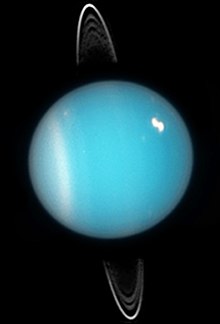 Uranus with clouds | |
| Hex triplet | #AFDBF5 |
| HSV (h, s, v) | (202°, 29%, 96%) |
| sRGBB (r, g, b) | (175, 216, 245) |
| Source | Color-Hex |
| ISCC–NBS descriptor | Very light greenish blue |
| B: Normalized to [0–255] (byte) H: Normalized to [0–100] (hundred) | |
Uranian blue is a light greenish blue, the color of Uranus.
Argentinian blue[]
| Argentinian Blue | |
|---|---|
 Flag of Argentina | |
| Hex triplet | #6CB4EE |
| HSV (h, s, v) | (206°, 55%, 93%) |
| sRGBB (r, g, b) | (108, 180, 238) |
| Source | [Unsourced] |
| ISCC–NBS descriptor | Light blue |
| B: Normalized to [0–255] (byte) H: Normalized to [0–100] (hundred) | |
The web color Argentinian blue is a light azure color seen on the national flag of Argentina.
Ruddy blue[]
| Ruddy Blue | |
|---|---|
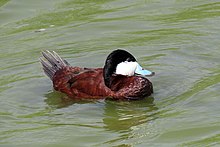 Ruddy duck (male) | |
| Hex triplet | #76ABDF |
| HSV (h, s, v) | (210°, 47%, 88%) |
| sRGBB (r, g, b) | (118, 171, 223) |
| Source | ColorSwatches |
| ISCC–NBS descriptor | Brilliant blue |
| B: Normalized to [0–255] (byte) H: Normalized to [0–100] (hundred) | |
Ruddy blue represents the coloring of the beak of the ruddy duck.
Celtic blue[]
| Celtic Blue | |
|---|---|
| Hex triplet | #246BCE |
| HSV (h, s, v) | (215°, 83%, 81%) |
| sRGBB (r, g, b) | (36, 107, 206) |
| Source | Encycolorpedia |
| ISCC–NBS descriptor | Vivid blue |
| B: Normalized to [0–255] (byte) H: Normalized to [0–100] (hundred) | |
Celtic blue is a shade of blue, also known as glas celtig in Welsh, or gorm ceilteach in both the Irish language and in Scottish Gaelic. Julius Caesar reported (in Commentarii de Bello Gallico) that the Britanni used to colour their bodies blue with vitrum, a word that means primarily "glass", but also the domestic name for the "woad" (Isatis tinctoria), besides the Gaulish loanword glastum (from Proto-Celtic *glastos "green"). The connection seems to be that both glass and the woad are "water-like" (lat. vitrum is from Proto-Indo-European *wed-ro- "water-like").
Spanish blue[]
| Spanish Blue | |
|---|---|
| Hex triplet | #0070BB |
| HSV (h, s, v) | (203°, 100%, 72%) |
| sRGBB (r, g, b) | (0, 112, 184) |
| Source | Gallego and Sanz[26] |
| ISCC–NBS descriptor | Strong blue |
| B: Normalized to [0–255] (byte) | |
Spanish blue is the color that is called Azul (the Spanish word for "blue") in the Guía de coloraciones (Guide to colorations) by Rosa Gallego and Juan Carlos Sanz, a color dictionary published in 2005 that is widely popular in the Hispanophone realm.
Bleu de France[]
| Bleu de France | |
|---|---|
| Hex triplet | #318CE7 |
| HSV (h, s, v) | (210°, 79%, 91%) |
| sRGBB (r, g, b) | (49, 140, 231) |
| Source | Pourpre.com |
| ISCC–NBS descriptor | Vivid blue |
| B: Normalized to [0–255] (byte) H: Normalized to [0–100] (hundred) | |
Bleu de France is a vivid blue color that has been associated in heraldry with the Kings of France since the 12th century.
Delft blue[]
| Delft Blue | |
|---|---|
| Hex triplet | #1F305E |
| HSV (h, s, v) | (224°, 67%, 37%) |
| sRGBB (r, g, b) | (31, 48, 94) |
| Source | [1]Derwent |
| ISCC–NBS descriptor | Dark blue |
| B: Normalized to [0–255] (byte) H: Normalized to [0–100] (hundred) | |
Delft blue is a dark blue color.
The name is derived from the Dutch pottery Delftware, also known simply as "Delft Blue".
Duck blue[]
| Duck Blue | |
|---|---|
| Hex triplet | #007791 |
| HSV (h, s, v) | (191°, 100%, 57%) |
| sRGBB (r, g, b) | (0, 119, 145) |
| Source | ISCC-NBS |
| ISCC–NBS descriptor | Moderate greenish blue |
| B: Normalized to [0–255] (byte) | |
Duck blue is a moderate greenish blue.
Resolution blue[]
| Resolution Blue | |
|---|---|
| Hex triplet | #002387 |
| HSV (h, s, v) | (224°, 100%, 53%) |
| sRGBB (r, g, b) | (0, 35, 135) |
| Source | Xona.com Color List |
| ISCC–NBS descriptor | Vivid blue |
| B: Normalized to [0–255] (byte) | |
Resolution blue is a vivid blue color.
This color name first came into use in 2001 when it was formulated as one of the colors on the Xona.com Color List.
Polynesian blue[]
| Polynesian Blue | |
|---|---|
| Hex triplet | #224C98 |
| HSV (h, s, v) | (218°, 78%, 60%) |
| sRGBB (r, g, b) | (34, 76, 152) |
| Source | ColorSwatches |
| ISCC–NBS descriptor | Vivid blue |
| B: Normalized to [0–255] (byte) H: Normalized to [0–100] (hundred) | |
Polynesian blue is a dark blue color, almost navy.
Moroccan Blue[]
| Chefchaouen Blue | |
|---|---|
| Hex triplet | #468fea |
| HSV (h, s, v) | (213°, 70%, 92%) |
| sRGBB (r, g, b) | (70, 143, 234) |
| Source | Color-Hex |
| ISCC–NBS descriptor | Vivid blue |
| B: Normalized to [0–255] (byte) | |
Moroccan blue (also Chefchaouen blue) is a vivid blue color.
Sapphire[]
| Sapphire | |
|---|---|
 Sapphire gemstone | |
| Hex triplet | #082567 |
| HSV (h, s, v) | (222°, 86%, 22%) |
| sRGBB (r, g, b) | (8, 37, 103) |
| Source | 99Colors |
| ISCC–NBS descriptor | Deep blue |
| B: Normalized to [0–255] (byte) H: Normalized to [0–100] (hundred) | |
Sapphire is a deep shade of navy blue, based on the color of an average sapphire gemstone. However, sapphires can also be pink, yellow, or orange.
Fluorescent blue[]
| Fluorescent blue | |
|---|---|
 Indian 50 rupee note, obverse | |
| Hex triplet | #15F4EE |
| HSV (h, s, v) | (178°, 91%, 96%) |
| sRGBB (r, g, b) | (21, 244, 238) |
| Source | [Unsourced] |
| ISCC–NBS descriptor | Brilliant bluish green |
| B: Normalized to [0–255] (byte) H: Normalized to [0–100] (hundred) | |
Fluorescent blue is a shade of blue that is radiant based on fluorescence. This is the main color on the Indian 50-rupee note.
Yale Blue[]
| Yale "Blue Site" Blue | |
|---|---|
| Hex triplet | #00356B |
| HSV (h, s, v) | (210°, 100%, 42%) |
| sRGBB (r, g, b) | (0, 53, 107) |
| Source | Identity Guidelines |
| ISCC–NBS descriptor | Deep blue |
| B: Normalized to [0–255] (byte) H: Normalized to [0–100] (hundred) | |
Yale Blue is the dark azure color used in association with Yale University. The hue of Yale Blue is one of the two official colors of Indiana State University,[27] the University of Mississippi,[28] and Southern Methodist University.[29] The official color "DCU Blue" of Dublin City University is very close to Yale Blue.[30]
Yale Blue was also an official color of University of California, Berkeley[31] and Duke University.[32]
Penn blue[]
| University of Pennsylvania Blue | |
|---|---|
 | |
| Hex triplet | #011F5B |
| HSV (h, s, v) | (220°, 98.9%, 35.7%) |
| sRGBB (r, g, b) | (1, 31, 91) |
| Source | Penn branding guidelines |
| ISCC–NBS descriptor | Deep purplish blue |
| B: Normalized to [0–255] (byte) H: Normalized to [0–100] (hundred) | |
Penn Blue is one of the official colors of the University of Pennsylvania, along with Penn Red. While the school colors were defined by 1910,[33] university history points to earlier times when the colors may have been chosen, including a possible visit by George Washington to the University, where students used the color of his tunic to determine school colors or a track meet where Penn athletes declared that they would wear the colors "of the teams we beat," which would be those of both Harvard University and Yale University.[34] Originally defined as the colors used on the American flag, the colors have since deviated.[33]
Berkeley blue[]
| Berkeley Blue | |
|---|---|
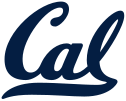 | |
| Hex triplet | #003262 |
| HSV (h, s, v) | (209°, 100.0%, 38.4%) |
| sRGBB (r, g, b) | (0, 50, 98) |
| Source | Berkeley branding guidelines |
| ISCC–NBS descriptor | Deep blue |
| B: Normalized to [0–255] (byte) H: Normalized to [0–100] (hundred) | |
Berkeley Blue is one of the official colors of the University of California, Berkeley, along with California Gold.[35] Until 2007, the university had used Yale Blue in its place, given Berkeley's historical ties to Yale University, particularly in its founding.[31] Berkeley's school colors are the originators for those of all the campuses in the University of California system, of which Berkeley is the oldest as its flagship.
Teal blue[]
| Teal blue | |
|---|---|
| Hex triplet | #367588 |
| HSV (h, s, v) | (194°, 60%, 53%) |
| sRGBB (r, g, b) | (54, 117, 136) |
| Source | Kelly, Kenneth L. and Judd, Deanne B. (December 1976) "Color: Universal Language and Dictionary of Names", National Bureau of Standards, Spec. Publ. 440 |
| ISCC–NBS descriptor | Moderate greenish blue |
| B: Normalized to [0–255] (byte) H: Normalized to [0–100] (hundred) | |
Teal blue is a medium tone of teal with more blue.
The first recorded use of teal blue as a color name in English was in 1927.[36]
See also[]
- List of colors
- Azure (color)
- Cyan
References[]
- ^ Jump up to: a b c d "W3C TR CSS3 Color Module, HTML4 color keywords". W3C. May 2003. Retrieved 2008-02-05.
- ^ "X11 rgb.txt". Archived from the original on 2015-11-07. Retrieved 2008-02-05.
- ^ Waldman, Gary (2002). Introduction to light : the physics of light, vision, and color (Dover ed.). Mineola: Dover Publications. p. 193. ISBN 978-0-486-42118-6.
- ^ web.Forret.com Color Conversion Tool set to color #0018A8 (Blue (Pantone)):
- ^ Type the word "Blue" into the indicated window on the Pantone Color Finder and the color will appear. There are seven versions, all with the same color codes—C, EC, HC, M, PC, U, and UP.
- ^ Pantone TPX Pantone Color Finder--Type the word "Blue" into the indicated window on the Pantone Color Finder and the color will appear. There are seven versions, all with the same color codes—C, EC, HC, M, PC, U, and UP.:
- ^ The sRGB values are taken by converting the NCS color 2060-B using the “NCS Navigator” tool at the NCS website.
- ^ web.forret.com Color Conversion Tool set to hex code #1F75FE (Blue (Crayola)):
- ^ Grossmann 1911.
- ^ web.forret.com Color Conversion Tool set to hex code #545AA7 (Liberty):
- ^ Color sample #196 on the ISCC-NBS color list is the color sample that matches the color in the book by Maerz and Paul A Dictionary of Color New York:1930 McGraw-Hill--Color Sample of Liberty: Page 109 Plate 43 Color Sample C12
- ^ Maerz and Paul A Dictionary of Color New York:1930 McGraw-Hill Page 197; Color Sample of Liberty: Page 109 Plate 43 Color Sample C12
- ^ Maerz and Paul A Dictionary of Color New York:1930 McGraw-Hill Page 103; Color Sample of Navy blue: Page 131 Plate 40 Color Sample E11
- ^ Maerz and Paul A Dictionary of Color New York: 1930 McGraw-Hill Page 199; Color Sample of Midnight: Page 103 Plate 40 Color Sample A8
- ^ web.forret.com Color Conversion Tool set to hex code of color #4C516D (Independence):
- ^ Maerz and Paul A Dictionary of Color New York:1930 McGraw-Hill Page 196; color sample of Independence: Page 117 Plate 47 Color Sample H12
- ^ "Ultramarine / #120a8f hex color".
- ^ "#5865f2 hex color".
- ^ Jump up to: a b Nelly (13 May 2021). "Happy Blurpthday to Discord, a Place for Everything You Can Imagine". Discord Blog. Retrieved 13 May 2021.
- ^ "#7289da hex color".
- ^ "#205896 hex color".
- ^ The color displayed in this color box matches the color called baby blue in the 1930 book by Maerz and Paul A Dictionary of Color New York:1930 McGraw-Hill; the color baby blue is displayed on page 93, Plate 35, Color Sample E2.
- ^ Maerz and Paul A Dictionary of Color New York:1930 McGraw-Hill Page 190; Color Sample of Baby Blue: Page 93 Plate 35 Color Sample E2
- ^ Maerz and Paul A Dictionary of Color New York:1930 McGraw-Hill Page 190
- ^ Maerz and Paul A Dictionary of Color New York:1930 McGraw-Hill Page 202. See color sample of powder blue, Page 95--Plate 36 Color Sample H2
- ^ Gallego, Rosa; Sanz, Juan Carlos (2005). Guía de coloraciones (Gallego, Rosa; Sanz, Juan Carlos (2005). Guide to Colorations) Madrid: H. Blume. ISBN 84-89840-31-8
- ^ "About - Indiana State University".
- ^ "Ole Miss Traditions: Red & Blue". University of Mississippi. October 1, 2002. Retrieved January 4, 2012.
- ^ "SMU SPIRIT AND TRADITIONS". Southern Methodist University. Retrieved January 4, 2012.
- ^ "Public Affairs and Media Relations Office - corporate identity - DCU identity - DCU".
- ^ Jump up to: a b "History, Symbols, and Traditions: What are Cal's official colors?". University of California, Berkeley. May 8, 2007. Retrieved December 3, 2007.
- ^ "The origin of Duke Blue". Duke University Libraries. Retrieved December 3, 2007.
- ^ Jump up to: a b "History of Penn Colors". University Archives and Records Center. University Archives and Records Center.
- ^ "History and Traditions". University of Pennsylvania Athletics. University of Pennsylvania Athletics. Retrieved 28 March 2020.
- ^ Colors | UC Berkeley Brand Identity. brand.berkeley.edu. Retrieved on April 6, 2014.
- ^ Maerz, Aloys John and M. Rea Paul (1930) A Dictionary of Color, New York, McGraw-Hill, p. 205; color sample of Teal Blue: p. 101 Plate 39 Color Sample L6
- Shades of blue
- Shades of cyan
- Shades of violet





